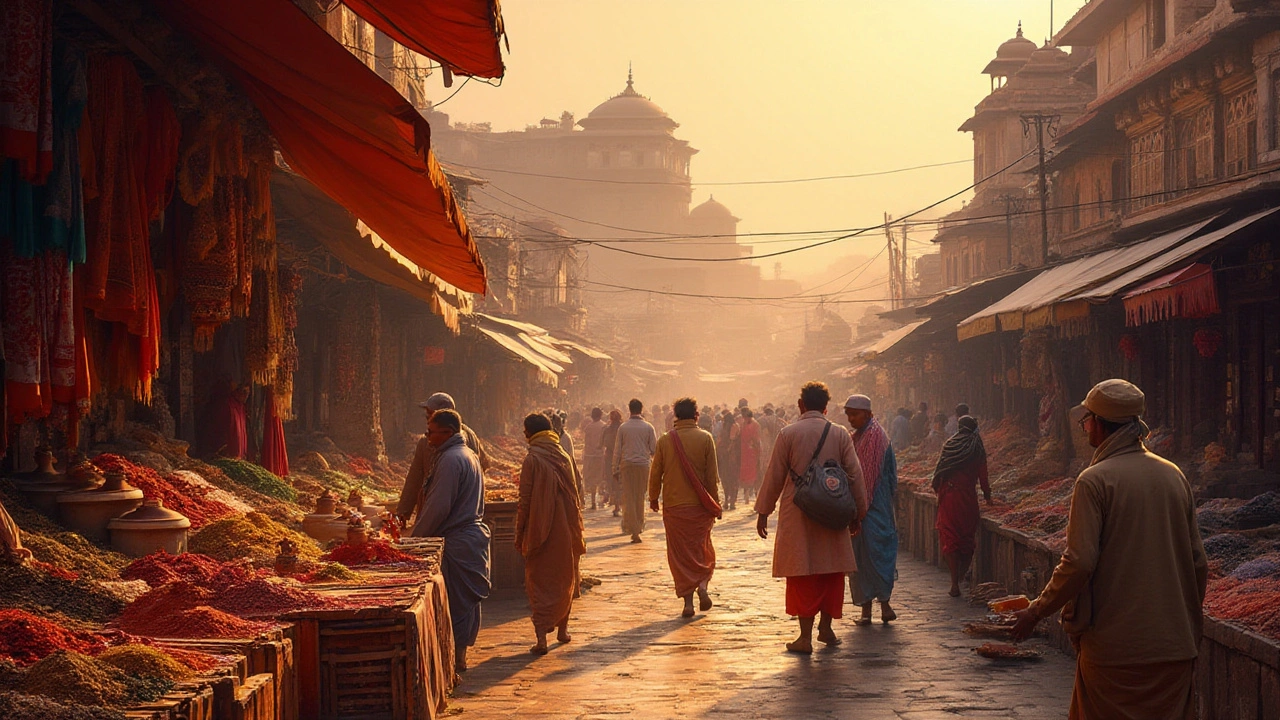India, a country defined by its vibrant tapestry of cultures, languages, and histories, sparks curiosity in many of its global visitors. When choosing between the North and the South, questions often arise regarding which region holds greater wealth—not just financially, but culturally and socially. Each region has its focus: North India captivates with its historical pomp, and the South allures with serene landscapes.
The North boasts grand forts and palaces, blending the glorious tales of past empires with buzzing markets in urban centers. The South charms visitors with lush green landscapes, pristine beaches, and ancient traditions that have thrived over centuries. Whether it’s the architectural wonders of Rajasthan in the North or the spiritual towns of Tamil Nadu in the South, understanding what makes each region tick offers travelers rich insights into the soul of India.
- Historical Context and Richness
- Cultural Wealth and Traditions
- Economic Landscapes
- Tourism Opportunities
- Lifestyles and Urbanization
- Comparative Insights
Historical Context and Richness
India's varied cultural tapestry is deeply rooted in a rich historical context that permeates every city, town, and village. North India has been a melting pot of numerous dynasties, empires, and cultures. From the ancient Indus Valley Civilization in modern-day Punjab and Haryana to the grand Mughal Empire, the North has seen the rise and fall of many great powers. This dynamic history is reflected in the majestic architecture such as the iconic Taj Mahal in Agra, a symbol of love and artistic achievement, and the stunning Red Fort in Delhi, a testament to the grandeur of the Mughal era. The medieval cities like Jaipur, with their pink-hued palaces and forts, continue to draw travelers seeking glimpses of royal splendor.
Conversely, South India presents an equally mesmerizing historical narrative, albeit more anchored in regional kingdoms and unique indigenous cultures. The region was home to the Cholas, Cheras, and Pandyas—dynasties that cultivated art, architecture, and literature. South India's temples, like the Meenakshi Temple in Madurai and the Brihadeeswarar Temple in Thanjavur, stand as architectural marvels adorned with intricate carvings that chronicle mythological tales and historic events. Trade affiliations with ancient Romans and Southeast Asians also contributed to a rich cultural interchange, shaping the contours of its historical landscape.
As you travel between these regions, you'll notice North India has historically been a battleground for empires vying for supremacy. The significance of the Delhi Sultanate and the Maurya Empire in shaping India's past cannot be overstated. These influences have left an indelible mark on the sociopolitical and cultural climate of the area, evidenced by the rich tapestry of festivals, music, and dance forms that are celebrated to this day. The strategic positioning of North India at the crossroads of Asia made it a vital conduit for trade, ideas, and cultural expressions.
In contrast, the lush valleys and coastal plains of South India offer a glimpse into a history that has thrived on maritime trade, agriculture, and traditional craftsmanship. The Dravidian architecture, distinct in its monumental towers or 'gopurams', signifies the artistic pursuits that have persisted through centuries. The tale of South India's wealth is a chronicle of spice trade routes, rich textiles, and ancient knowledge systems in Ayurveda that have captivated the world. As observed by a reputable historian,
"South India's chambers are echoed with the timeless eloquence of traders, poets, and philosophers who have shaped its storied past."
The entwined histories of North India and South India reflect a deep and enduring richness that sets these regions apart yet binds the nation in its shared legacy. Their historical northern and southern fronts continue to influence India's global standing, beckoning travelers to explore and experience their profound narratives firsthand. This convergence of past and present not only aids the economy through tourism but also fosters an appreciation of India's multifaceted identity.
Cultural Wealth and Traditions
India is synonymous with rich cultural heritage, where the North and South each contribute uniquely to the nation’s diverse mosaic. In the North, cultural traditions largely revolve around historic influences from empires like the Mughals, who left behind an architectural legacy with magnificent edifices like the Taj Mahal. Known for grand festivals such as Diwali and Holi, North India adds a colorful spectacle to its cultural tableau. In North India, the music, dance, and art forms often reflect the grandeur of these historical epochs, with classical music and folk dances such as Kathak being prominent.
Venturing into the South India, one encounters a different yet equally rich cultural tapestry. The region captivates with its dedication to classic arts and spiritual traditions. Dance forms like Bharatanatyam and the rhythmic beats of Carnatic music have a divine association and perform a significant role in cultural expressions. Temples like those in Tamil Nadu echo stories of dynasties past and are central to social and religious life. Moreover, festivals of the South, including Pongal and Onam, showcase agrarian roots and the gratitude of communities to nature and its bounties.
"India's architectural and cultural wealth unveils the stories and traditions of different regions, bringing history and heritage to life," said historian Priyanka Das in an interview with 'Cultural Heritage Magazine'.
Interestingly, the craft techniques in both regions speak volumes about their cultural heritage. While the block printing and carpet weaving industries in the North add elegance to homes worldwide, the South is known for its silk weaving, especially the Kanchipuram silk saris that are renowned for their vibrant colors and fine weaving. This cultural exchange through craft often acts as a bridge linking these diverse regions.
| Region | Famous Craft | Signature Festival |
|---|---|---|
| North India | Block Printing | Holi |
| South India | Silk Weaving | Pongal |
Cultural festivals, rich traditions in publishing literature, and regional cuisines are upholders of North and South India's lush traditions. While land has been traversed on foot by sages and historians seeking wisdom, the written word continues to carry these stories far. Literature, in both Hindi and regional languages such as Tamil and Telugu, flourishes with poetry, short stories, and epics, linking ancient wisdom with contemporary themes. The cultural wealth of both regions goes beyond tangible arts; it finds deeper threads interlaced with everyday practices, ensuring that both North and South India’s riches continue to inspire identities within communities and visitors alike.
Economic Landscapes
When we examine the economic landscapes of both South India and North India, a fascinating mosaic of contrast and convergence emerges. The southern states, with their bustling information technology hubs like Bengaluru and Hyderabad, have established themselves as powerhouses in the tech industry. These cities attract top talents and investments from across the globe, effectively contributing to the region's growing GDP. The robust infrastructure, coupled with progressive policies, has made South India an appealing choice for startup ecosystems, creating a buzz in innovation-driven fields and paving paths for future growth. The combination of skilled labor and IT advancements continues to fortify its position in these highly competitive sectors.
In contrast, North India recasts its economic strength through other substantial sectors. With states like Punjab and Haryana, agriculture remains a decisive part of the economy. Known as the nation's 'Breadbasket', these states contribute significantly to food production with their vast expanses of fertile lands. In recent times, a shift towards agri-tech and sustainable farming methods has been observed, hinting at a dynamic evolution in how agriculture interfaces with technology and sustainability. Moreover, this region is intertwined with traditional industries such as textiles and handicrafts, which have both domestic and international markets. These economic pillars provide livelihoods to many, intertwining skills passed down through generations with modern-day commerce.
The economic growth of these regions is further symbolized through major infrastructure projects. For instance, the Delhi-Mumbai Industrial Corridor and the Chennai-Bangalore Industrial Corridor are ambitious projects directed at improving connectivity and fostering industrial expansion. Such projects underscore the focus on boosting regional economies through enhanced logistics and manufacturing capabilities. It is notable how initiatives like the performance-linked incentive schemes aim to streamline manufacturing efforts, reflecting a national agenda of self-reliance and export promotion. These infrastructural advancements serve to propel both North and South India on economic parameters, underscoring their roles in national progress.
As noted by a report from the NITI Aayog, "The diversity in economic models across Indian states exemplifies the nuanced approaches necessary for addressing the distinct challenges and opportunities in each region."
The economic landscapes also uniquely influence urbanization patterns. Cities in the North, like Delhi and Jaipur, experience distinct urban growth marked by burgeoning populations and high-paced lifestyles. Meanwhile, the South sees rapid urbanization in cities like Chennai and Kochi, driven significantly by migration of tech professionals and expansion of industrial sectors. As these urban centers expand, they grapple with challenges of urban planning, sustainable living, and resource management. As southern cities add to their skylines with smart city projects, northern counterparts delve into revamping historical cityscapes to meet modern needs. These intentional efforts aim to realize a future-facing vision that preserves cultural identity while fostering progress.
The financial undercurrents in both regions present unique investment opportunities. The South’s stronghold in sectors like IT and fintech has drawn substantial foreign direct investments, reinforcing its economic vitality. Meanwhile, Northern India’s focus on enhancing industrial productivity, especially in automotives and food processing, has turned it into an appealing destination for investment amid potential market expansions. The distinctive economic landscapes reflect the copious opportunities and challenges unique to each region, forming the economic identity that makes India an intriguing stakeholder in global economic dialogues.

Tourism Opportunities
When it comes to tourism opportunities, both South India and North India showcase an array of experiences that cater to diverse tastes and interests. North India tends to capture the imagination with its rich tapestry of historical wonders and royal palaces. Take the stunning Taj Mahal in Agra, which continues to be one of the most sought-after destinations globally. Its marble domes and intricate carvings stand as a testament to India's rich history. The vibrant city of Jaipur, known as the Pink City, offers sprawling forts and lively bazaars that get you lost in time. Heading towards the Himalayan foothills, one finds cities like Rishikesh and Haridwar, revered for their spiritual significance and adventure sports like white water rafting.
South India, on the other hand, is a treasure trove of natural and cultural wealth. Places like Kerala, affectionately known as 'God’s Own Country', provide more than just tropical beauty with their serene backwaters and lush landscapes. The houseboat experiences cruising through the placid waters offer a soothing escape from the hustle and bustle of everyday life. In Tamil Nadu, you can marvel at the architectural brilliance of ancient temples like the Brihadeeswarar Temple, known for its towering gopurams and exquisite sculptures. For wildlife aficionados, the Periyar National Park presents a chance to spot elephants and tigers in their natural habitat.
Both regions also boast bustling urban experiences where modernization blends effortlessly with tradition. Delhi, with its contemporary lifestyle juxtaposed against ancient stories, offers cosmopolitan tastes and culinary delights, ranging from street food to fine dining. In the South, Bengaluru—dubbed the Silicon Valley of India—thrives with technology and innovation, yet preserves beautiful parks and a vibrant arts scene. A traveler quoted in the well-regarded 'Lonely Planet' guide said,
"Whether you choose the north or the south, India never ceases to amaze. Each region offers a different nuance of spirituality, culture, and modernity."
The diversity in both regions extends to their respective tourism services, with equally charming hill stations like Shimla in the North providing snowy sanctuaries, and Ooty in the South offering misty woods and tea plantations. Flight connections and hotel accommodations offer varying ranges that can fit both budget and luxury travelers. Crucially, a successful journey in these regions often relies on understanding the timing of travel. The winter months from November to March are generally favorable for visiting the North, avoiding scorching summers and unpredictable monsoons. Conversely, the cooler months are also ideal for the South, especially for beachgoers keen on exploring coastal lines.
Lifestyles and Urbanization
In exploring the lifestyles across North India and South India, the curious traveler will find a remarkable tapestry of differences shaped by centuries of tradition and modern influence. In the northern parts, where history echoes from the stone corridors of Delhi to the sacred riverbanks of Varanasi, traditional living intersects with rapidly advancing urbanization. Major cities such as Mumbai, often considered the economic powerhouse of India, boldly embody this transition—they host sprawling business districts while retaining thriving local markets filled with age-old crafts. Housing in Northern cities often stacks high into the sky—a testament to their burgeoning populations and limited space, resulting in a harmony of the traditional and contemporary lifestyle. Yet, amidst this urban surge, the deeply embedded cultural practices continue to assert their identity, manifesting in vibrant festivals, colorful attire, and flavorsome cuisines.
Heading south, the pace gently shifts. Cities like Bangalore, renowned as the 'Silicon Valley of India,' highlight the symbiosis of technology and culture. Contrasted with its IT parks and start-up hubs, the South cherishes leisurely walks through verdant tea plantations in Kerala or the rich spiritual heritage of steel towns like Trichy. Urban living in many parts of South India is marked by more horizontal expansion, emphasizing sprawling bungalows amidst lush greenery rather than multi-storied high-rises. Here, rapid technological growth and entrepreneurship surge alongside the preservation of ancient art forms, including classical dance and music, sealing a unique lifestyle offering a blend of calmness and creativity.
The Urban-Rural Nexus
This urban-rural blend extends through both regions, yet reveals subtle distinctions. In North India's countryside, the rural areas serve as the custodians of the subcontinent’s agrarian traditions, extending large swathes of land into vibrant fields growing grains blessed by the Sun God in endless rows of golden wheat. Contrarily, the Southern hinterlands, with their red earth turning green during monsoon seasons, grow luxuriant rice paddies that punctuate coconut palms as far as the eye can see. This not only exemplifies a geographical difference but echoes the symbiotic relationship between rural sustainability and urban growth, offering cities a hinterland rich in resources.
Urbanization Trends and Effects
Urbanization has ignited unprecedented development in infrastructure; however, it also brings challenges such as congestion and uneven resource distribution. A longstanding focus on sustainability leads both regions to pursue uniquely Indian solutions, from smart city initiatives consolidating tech advancements with traditional practices to developing eco-friendly public transportation. In tandem, their lifestyles adapt, blending new flexible work environments with long-established familial structures, culminating in a modern Indian ethos—diverse, dynamic, and continually evolving. Experts often note this evolution captures a recognition and synthesis of indigenous wisdom with modern challenges. A notable statement from economist Dr. Arvind Krishna notes,
"India’s urban future rests not only in the numbers but in how deftly it handles the convergence of its storied past with unprecedented modernization."This illustrates that while metrics evaluate progress, culture, and innovation, are what deeply jade the cities' character, making each diverse blueprint both unique and yet unmistakably Indian.
Comparative Insights
The diversity within India is not only evident in culture but also in the economic dynamics that define South India and North India. Historically, the North has had the edge with ancient empires and trade routes impacting its wealth. Cities like Delhi and Jaipur are filled with relics of their grandeur, boasting monuments that tell stories of bygone eras. In contrast, the South is acclaimed for its economic strides in recent years, with cities like Bangalore emerging as tech and innovation hubs.
Comparing these regions economically, it's evident that industrial development has set the stage for defining wealth. South India enjoys a growing information technology sector, while the agrarian economy persists in parts of the North. The knowledge economy contributing to cities like Hyderabad positions the South as a forerunner in tech advancements. The North, revered for its traditional industries, continues to thrive on departmental outputs like textiles and agriculture.
One can delve into the tourism sector to further comprehend their richness. In North India, the opulence and age-old heritage accounted in structures like the Taj Mahal and Red Fort continue to draw not only tourists but significant revenue. Conversely, the South with its serene backwaters in Kerala, and temple towns like Madurai, attract those seeking the peace of mind and pristine surroundings. Here, tourism pivets on the natural and spiritual landscape, alluring a different audience.
Lifestyles in the two regions paint another contrasting picture. The North, with its bustling cityscape, witnesses a mix of traditional and contemporary living as seen in metropolitan hubs. On the flip side, South Indians with a focus on education and a diverse ecological setting foster a lifestyle that seems more grounded. Perhaps it's what makes the South’s quality of life index a point of interest compared to the fast-paced North.
"We're not here to judge wealth through tangible assets only," says Arundhati Bhattacharya, a respected Indian banking consultant. "It's also about cultural capital, resilience, and the strides toward modernization that both parts are achieving in their distinctive ways."
While one might think of riches in monetary terms, the cultural wealth each carries speaks extensively of what they offer. Both regions may reflect different socio-economic statuses, but they complement the Indian identity as a whole. Thus, when picking sides, remember it's neither about who fares better; it’s also about celebrating the uniqueness they inject into the Indian subcontinent.
| Region | Major Cities | Key Economic Activities |
|---|---|---|
| North India | Delhi, Jaipur | Textiles, Agriculture, Tourism |
| South India | Bangalore, Chennai | IT Industry, Manufacturing, Tourism |



